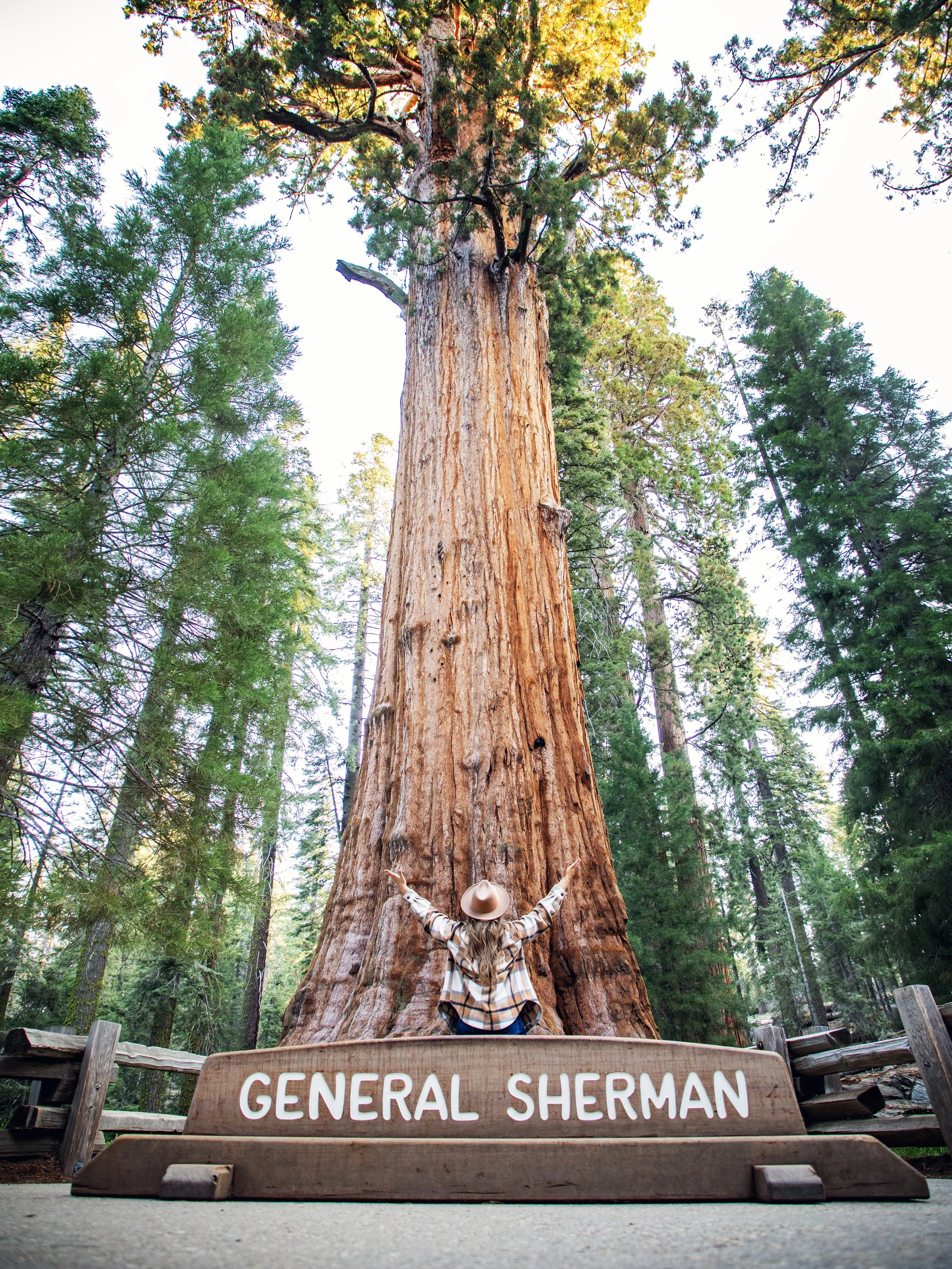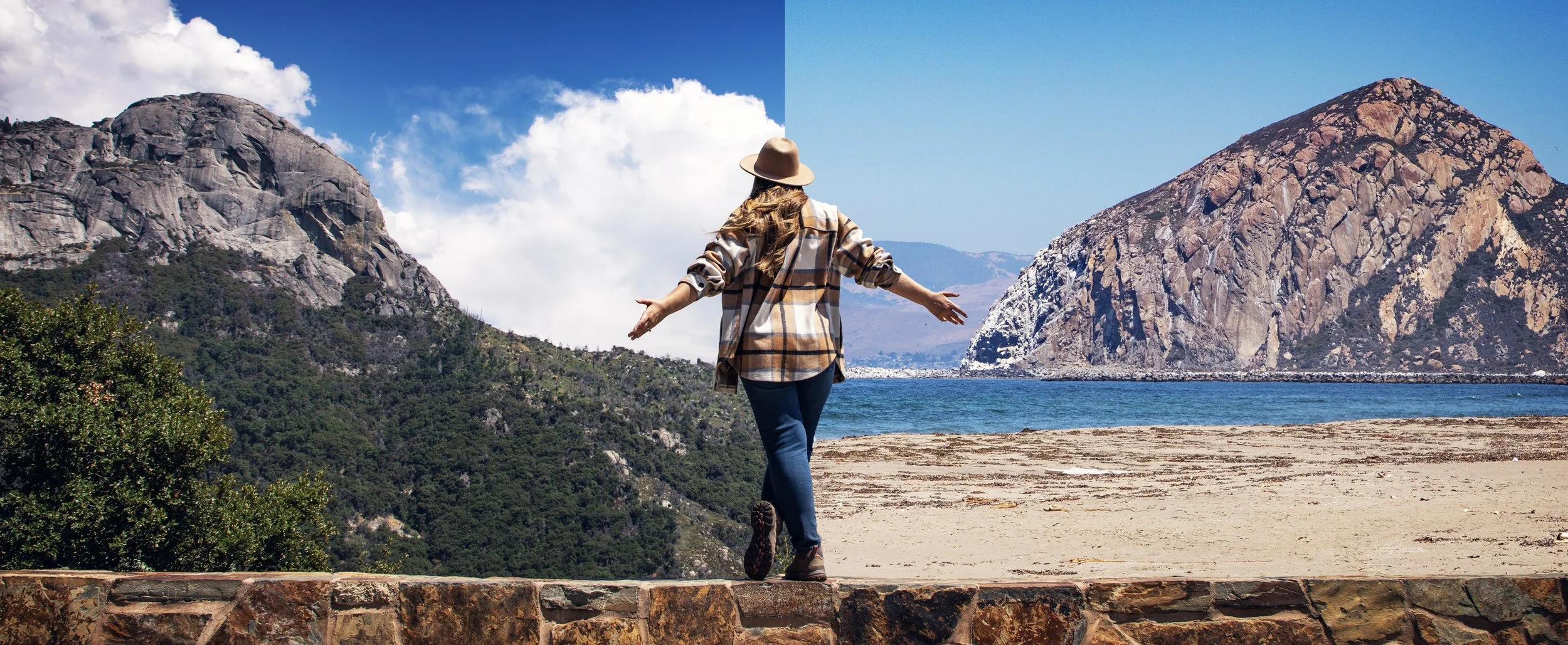New 2026 U.S. National Park Fees Explained: What Visitors Need to Know (Residents & Nonresidents)
Yesterday, the U.S. Department of the Interior and the National Park Service announced the most significant changes to national park entrance fees and access guidelines in decades, with updates rolling out nationwide beginning January 1, 2026. With so much conversation (and confusion) happening online, I wanted to break down exactly what’s changing, what’s staying the same, and what this means specifically for travelers heading to West Coast parks like Yosemite and Sequoia & Kings Canyon.
This guide is designed to give you the facts straight from the official releases, with no added opinions or politics...just clear, easy-to-understand information. And at the end of this post, you’ll find a Flying Dawn Marie Recommendations section with practical tips for both U.S. residents and international travelers planning a national park trip in 2026.
General Sherman Tree in Sequoia National Park
Overview: What’s Changing in 2026
Beginning January 1, 2026, the National Park Service will launch a modernized access system aimed at improving convenience, expanding digital pass options, and introducing a new “resident-first” fee system. Here are the highlights:
• Digital America the Beautiful passes will launch: All America the Beautiful passes (including Annual, Military, Senior, 4th Grade, and Access passes) will be available digitally on Recreation.gov. You’ll be able to purchase a pass and use it instantly from your phone.
• New pricing, primarily for nonresidents: U.S. residents will continue to pay current rates for most passes. Nonresidents will pay higher rates.
• New nonresident fees at 11 of the most popular national parks: These include Yosemite and Sequoia & Kings Canyon (see full list below).
• Updated 2026 pass artwork: New designs will feature modernized graphics and several high-profile images, including portraits of U.S. presidents (such as Presidents Washington, Trump, and Roosevelt).
• Resident-only free entrance days: Fee-free days are changing and expanding to 10 days, but starting in 2026 they only apply to U.S. citizens and residents.
• Motorcyclists get expanded access: All America the Beautiful passes will cover up to two motorcycles per pass.
• Fee revenue stays in the parks: Although this isn’t a change, it’s worth noting that 80% of entrance fees will stay in the park where they’re collected, helping fund maintenance, facility upgrades, and visitor services.
Mammoth Hot Springs in Yellowstone National Park
Digital Passes: What You’ll See in 2026
A major component of the update is full digital integration of America the Beautiful passes.
What’s New:
• All pass types will be available on Recreation.gov.
• Passes can be stored on your phone and linked to a physical card if you want one.
• Digital validation tools will speed up entry lines.
• Field staff will receive updated training to streamline the process.
This change means you can skip waiting for a physical pass to arrive in the mail and avoid the common issue of forgetting your pass at home.
What Stays the Same:
• You can still pick up physical passes at over 1,000 locations nationwide.
• Online orders from the USGS store will still be physical (not digital) and may take up to three weeks to deliver.
South Rim in Grand Canyon National Park
New Resident vs. Nonresident Pricing
One of the biggest upcoming changes is a shift toward a “resident-first” pricing structure.
Annual Pass (America the Beautiful)
• U.S. residents: $80
• Nonresidents: $250
A new nonresident-specific annual pass will be introduced at the $250 price point. All other America the Beautiful passes, including Senior, Access, Military, and 4th Grade, will only be available to U.S. citizens or permanent residents.
El Capitan & Merced River in Yosemite National Park
New Nonresident Surcharges at Popular Parks
Starting in 2026, nonresidents without an annual pass will pay a $100-per-person surcharge at 11 major national parks, in addition to the standard entrance fee. These parks include:
• Yosemite
• Sequoia & Kings Canyon
• Yellowstone
• Grand Canyon
• Grand Teton
• Glacier
• Rocky Mountain
• Zion
• Bryce Canyon
• Everglades
• Acadia
If you're a U.S. citizen or permanent resident, nothing changes for you regarding additional surcharges. If you’re a nonresident international visitor, this is a significant new cost to consider, especially at Grand Canyon, Yellowstone, and Yosemite, three of the most internationally traveled parks in the system.
2026 America the Beautiful Park Pass designs
2026 Park Pass Designs: A Look at the New Artwork
During Secretary Doug Burgum’s announcement video, several of the new 2026 pass designs were previewed. Sparking lively conversations online, these updated visuals are intended to be more modern, patriotic, and reflective of America’s outdoor heritage. Designs shown include:
• Annual Pass: Portraits of President George Washington and President Donald Trump
• Annual Pass (alternate design): Photo of Glacier National Park
• Volunteer Pass: Photo of President Theodore Roosevelt
• Military Pass: Photo of President Donald Trump saluting troops
• Senior Pass: Photo of Independence Hall
Crowds at Tunnel View in Yosemite National Park
2026 Resident-Only Free Entrance Days
The NPS will continue to offer annual fee-free days, but beginning in 2026, they apply only to U.S. citizens and residents. Nonresidents will be required to pay entrance fees and any applicable nonresident fees, even on these days. Fee-free dates include:
• February 16: Presidents Day
• May 25: Memorial Day
• June 14: Flag Day/President Trump’s birthday
• July 3–5: Independence Day weekend
• August 25: National Park Service 110th Birthday
• September 17: Constitution Day
• October 27: Theodore Roosevelt’s birthday
• November 11: Veterans Day
Glacier Point Road in Yoemite National Park
Motorcycle Access: Expanded Coverage
Starting in 2026, all America the Beautiful passes will cover up to two motorcycles instead of just one. This is a notable update for motorcyclists who travel in pairs or ride separately but share a pass. This applies to Annual, Senior, Military, Volunteer, Access, and 4th Grade Passes.
Yavapai Point in Grand Canyon National Park
What’s Staying the Same
Even with all the updates, some core features of national park access remain unchanged:
• Many NPS sites remain free: The majority of NPS-managed locations don’t require an entrance fee.
• One pass covers one private vehicle or four per-person fees: Depending on the site’s fee structure.
• Standard, park-specific annual, and interagency passes continue: These remain the primary options for covering entrance costs.
• Fee revenue stays in the NPS: At least 80% of entrance fees remain in the park where they were collected, funding visitor facility upgrades, trail work, campground improvements, maintenance projects, and general services. For more information on how these fees are used, check out the Your Fee Dollars at Work page on the official NPS website.
General Grant Tree in Kings Canyon National Park
What This Means for Travelers to Yosemite & Sequoia/Kings Canyon
Since many of my readers are west coast travelers, here’s the breakdown of how this will affect Yosemite and Sequoia/Kings Canyon visitation:
If you're a U.S. resident:
• Standard entrance fees remain unchanged.
• America the Beautiful Pass is still $80.
• No surcharge applies.
If you're a nonresident:
You will either pay:
• $250 for the new nonresident annual pass, or...
• The regular entrance fee plus a $100-per-person surcharge.
Planning Tips:
• Expect lines at entrance stations to move more quickly due to digital pass validation in the long run, with an understanding that there may be challenges initially, showing park rangers patience as they roll out this new system.
• Free days in 2026 apply only to U.S. citizens and residents.
• Still check for timed-entry systems, especially in Yosemite National Park. These policies are separate and may still apply during peak summer hours and Firefall season in February.
Half Dome views from Glacier Point in Yosemite National Park
Flying Dawn Marie Recommendations
Planning a national park trip in 2026 is going to look a little different, especially with new resident-based pricing, digital passes, and additional surcharges at parks like Yosemite and Sequoia & Kings Canyon. These are my personal recommendations based on the official information released so far and what I’ve learned from years of navigating these parks firsthand.
For U.S. Residents
Support small businesses in gateway communities. Towns like Oakhurst, Mariposa, Visalia, Three Rivers, and so many others rely heavily on tourism. With the likelihood of decreased international visitation, buying local (coffee shops, restaurants, lodging, tours, general stores) will make a meaningful difference in keeping these communities thriving.
Consider buying the $80 Annual Pass if you visit national parks often. This remains one of the best deals in outdoor travel. The new digital pass option might be especially helpful if you’ve ever lost a physical pass. Just be ready for the inevitable “learning curve” in the early months of 2026 as parks roll out digital scanning equipment. A little extra patience at entrance gates will go a long way...and our rangers deserve grace while adapting to a major nationwide transition.
Unsure about the new pass artwork? Single-visit entrance fees are still an option. Pass designs featuring political figures and historic imagery are currently one of the most debated pieces of this announcement. If displaying the artwork on your pass doesn’t sit well with you, choosing to pay standard one-time entrance fees is still a completely valid option. At this time, it’s unclear whether passholders can choose between designs or whether artwork differs for residents vs. nonresidents.
For Nonresidents of the U.S.
If visiting any of the 11 major parks mentioned above, the $250 Annual Pass may offer better value. It’s a significant upfront cost, but if you're visiting with family or traveling to more than one major park, it may save you money compared to the new $100 per-person surcharge at Yosemite, Sequoia & Kings Canyon, Glacier, Zion, Yellowstone, Grand Canyon, and other high-traffic parks.
Look into authorized park tour companies. Companies like Yosemite 360 Tours and Discover Yosemite Tours typically include entrance fees in their pricing. This means nonresident guests may be able to enter the park without paying the additional per-person surcharge themselves. I recommend contacting tour companies directly to confirm whether they expect any pricing changes for nonresident travelers in 2026.
For Yosemite travelers: consider using YARTS. As of the latest updates, YARTS (Yosemite Area Regional Transportation System) does not plan to raise fares in 2026...though this may change. A round-trip YARTS ticket includes park entry, making it a potentially cost-effective option for international visitors. Once inside the park, you can use the free Yosemite shuttles to explore. Since the announcement just happened, YARTS and other national park regional transportation services may still be scrambling to understand how this affects them. I’d recommend giving it a week or two and then reach out directly with questions about any additional fees for international visitors.
Avoid visiting on fee-free days. Holiday weekends like Memorial Day, Independence Day, and the NPS’s 110th birthday will likely be some of the busiest days of the year, and free entrance will apply only to U.S. residents. Nonresidents will still pay standard entrance plus the $100 per-person surcharge at applicable parks. If you want the smoothest experience, choose any other day.
Zumwalt Meadow in Kings Canyon National Park
Frequently Asked Questions
Will I still need a reservation to enter some parks?
Possibly. Reservations and timed-entry systems are separate from entrance fees. Some parks may continue requiring reservations for overcrowded areas or specific attractions. Always check the official NPS park website for the most up-to-date information on park reservations.
Do standard one-park passes change?
No. Standard 1–7 day passes for individual parks remain available and still directly support the park where you buy them. However, there will be an additional $100-per-person fee for nonresidents of the U.S. at certain high-trafficked parks.
Are any passes still free?
Yes. These passes remain free for eligible U.S. residents: Military Annual Pass, Military Lifetime Pass, Access Pass, 4th Grade Pass, and Volunteer Pass (250 service hours).
Do Senior Pass prices change?
No. Senior Annual ($20) and Senior Lifetime ($80) passes remain the same for U.S. citizens.
Can nonresidents get Senior, Access, or Military Passes?
No. These passes will only be available to U.S. citizens and permanent residents starting in 2026.
Do digital passes replace physical cards?
No. You can still request or pick up a physical pass if you prefer. Digital is just an added option.
Can the digital Annual Pass be used now?
Yes, but only the Annual Pass. Other passes won't be available digitally until 2026.
Does the $100 surcharge apply to everyone at Yosemite and Sequoia?
No. It applies only to nonresidents without an annual pass.
Tunnel Log in Sequoia National Park
Downloadable Itineraries & Travel Guides
Planning a trip to California and the west coast? I’ve got in-depth travel guides and itineraries for several national parks and beautiful destinations. Check out a few of them below, or click here to see them all!
Old Faithful Geyser erupting in Yellowstone National Park
In Summary
These 2026 updates represent some of the largest shifts in national park access in many years. Whether you visit Yosemite every summer, love fall colors in Sequoia, or road trip across multiple western parks, it’s important to understand how these changes may affect your travel planning. My goal with this post is to help you stay informed so you can make the best decisions for your adventures. I’ll continue updating this article if additional details are released. Until next week, I hope you find adventure and encouragement wherever you go.
Yosemite Falls roaring in Spring
If you enjoyed this post, you might also like…
About Me
I’m Dawn Marie, a travel and lifestyle blogger based out of Southern California. With in-depth articles, travel guides, and reviews on hotels & products, I seek to share my journeys to help you plan for your own. My adventures take me all over California, the western United States, and around the globe...and every Monday I post new content here, including a comprehensive blog post and YouTube video.
Search the Blog
Featured Posts
Etsy Shop




























